Thursday, November 01, 2007
Wednesday, October 24, 2007
Tuesday, October 23, 2007
NetHope Summit 2007
International Rescue Committee CTO David Goodman and IT Director Chad Sutton are down in Panama for the NetHope Summit and they are blogging!Stay tuned here all day long.
Wednesday, October 17, 2007
IRC Recruitment Video
We're thinking of doing a recruitment video - something that showcases our amazing culture and people... we're still brainstorming and are not sure if this is the right direction:Lip Dub - Flagpole Sitta by Harvey Danger from amandalynferri on Vimeo.
Or something more like this:
Friday, October 12, 2007
A Tiny Bit More About Youtube
Here's a snap shot of referral traffic from youtube to our site. Notice the bump (youtube program went live) and the falloff.Also notice (click the image to make it bigger) the conversion stats to our petition. Interesting that conversion is so much higher from /watch than from our profile. I need to take a closer look to see why - it's probably obvious!
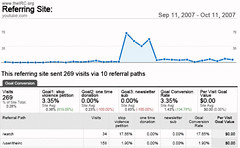
Labels: Social Networking, The International Rescue Committee
Friday, October 05, 2007
Keepin On, Keepin On
So busy here my head hurts!I sent out an advocacy e-mail yesterday to about 55,000 people. 2 noteworthy things happened.
First, we cross promoted the GuluWalk to our advocacy list. It seemed/felt very odd promoting another organization's fundraising event and still does a little bit. That said, I used GuluWalk's online fundraising tools to create a TeamIRC (US, Canada and International) to try to keep our brand growing. We've had quite a response, signing up about 25 people so far - and raising a few bucks to boot. I've noticed organizations like Worldvision and Save the Children cross promote different advocacy events before, and had always wanted to try it. It feels good to represent a brand that is willing to promote it's partnerships.
Secondly, we've been working closely with a company called Collactive. In the same advocacy e-mail we included this copy:
TAKE ACTION NOW
The United States has failed in its pledge to provide refuge to thousands of extremely vulnerable Iraqi civilians, including those who worked for Americans in Iraq and whose lives are at grave risk as a result.
Of 4 million uprooted Iraqi civilians in desperate need of help, only a paltry 1,608 refugees were admitted into the United States this year.
Read Anna Husarska's LATimes op-ed and click Act Now! to email it to the U.S. Government.
When users clicked on "Act Now!" they were taken to a Collactive generated interface which allowed them to forward the story to the U.S. Government. Because Collactive's system uses the actual site (LATimes in this case), our story was suddenly #2 on the most emailed stories. A day later (i.e. right now - we're #1). How cool is that?
Yes, the traffic is not to our site - and yes - the latimes article doesn't have a link to our site (but does list our URL) so results are impossible to track. But that said - an important mission story went from invisible, to very visible by simply utilizing our advocacy email list.
Click the pics below to get a full screen view.
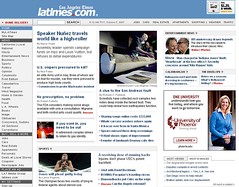
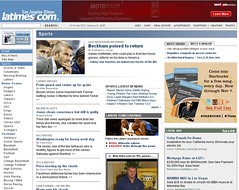
Friday, September 28, 2007
Building a Community, Part I: Why Bother?
I am planning on doing a series of blog posts around a new (and until now, highly secretive) initiative that we are working on at the International Rescue Committee.Full disclaimer, I’ll be as honest and open as possible, but please expect that I’ll reserve the right to gloss of some details and ideas that I feel could be too easily adapted by others, thereby reducing the effectiveness of what we are building, or planning to build.
Part I “Why bother building a community”
If I am being totally honest, the impetus for the creation of an online community at the IRC revolves around something I hinted at in an earlier post. The IRC needs a platform – a way to engage people, build their involvement beyond making donations and coming to various traditional fundraising events and volunteerism. And yes, we’re thinking of a younger demographic as well.
But past the IRC needing new sources of revenue, what the IRC really needs is a way to engage a community of people who care about what we’re up to in war zones in an open, honest dialogue about what they can do to help – and how the IRC will use their involvement to accomplish it’s mission of rescuing and rebuilding lives and communities.
So what is it?
Good question. My team and I have looked at what seems like every community being run by a non-profit. From the super basic of “we have an email newsletter, and that is community” to the uber-engaged organizations like Greenpeace and March of Dimes Share Your Story, there is a ton of variation and differences. And each one was created for different reasons. New ones seem to pop up ever day.
But before I go too deep, let me make a distinction. At the ORGANIZATIONAL level, every business whether it be for-profit or non-profit most certainly has a loosely defined “community.” It’s easy to join this community, sign up for their e-mail newsletter or give them a donation and just like that, you are part of a community. At that level, I guess I’m part of the New Balance community because I wear NB sneakers. Not a very deep connection, but still… loosely defined it is a community of sorts. And this is of course the problem with communities – the connection is often too loose, or based on a shallow or single transaction. It's too easy to take for granted the relationship you think you have with a supporter.
I’m not honestly all that interested in loose, brand communities. Despite the fact that Apple has created a movement and Nike rallies athletes everywhere to “Just Do It” – these communities of consumers aren’t really interacting with and for each other at any level other than as a consumer. We need to do better in order to affect real change in the world.
Nike created Joga.com, an online community for soccer fans. DVDTalk is a thriving online community for people who love movies and DVD’s. Netflix is as well. Why can’t Blockbuster keep up and why are they shaking in their shoes… Netflix has built a huge community of people who can connect to each other around the movies they love. They can share RSS feeds and rate their favorite movies. That’s closer.
Even closer still is what I helped to build at the March of Dimes. The Share Your Story community was started as a way for us to reach out to a new audience (i.e. mother’s of premature babies). We had just shifted our focus to prematurity, and realized that there wasn’t a dominant community of moms sharing stories, helping each other and telling their stories. Babycenter and iVillage had basic message boards, but they were lost in a sea of other topics, none specific enough to really attract such a targeted set of women.
So we opened the doors a few years ago and let them meet each other, share their photos and tell their stories. Not only did the community build itself (today to the tune of 20,000 people), but it turns out that the community is enormously involved in fundraising. Going back to my original point about the impetus for creating community to drive fundraising I can say that we did imagine a day where the community would raise a few bucks, but never did we imagine to what scale it would contribute (my data is old, but I’m making an educated guess that “family teams” which were created along with the new online community now generates millions of dollars a year via WalkAmerica).
So why build a community? The answer is complex and yet so simple!
Build a community if you are interested in long term brand success – develop brand evangelisgts, loyal donors, advocates and employees. That’s why. Next comes the really hard part… how to do it.
Labels: marketing, Social Networking, The International Rescue Committee
Thursday, September 20, 2007
12 Keys to Working with a Pro Bono Agency
A new friend of mine asked me to jot down 12 (why twelve?) things to think about when working with a pro-bono agency. If you are thinking of going the pro-bono route to help you with marketing and branding, here is a starter list of 12 things to consider - in no particular order.Full disclaimer: International Rescue Committee is working with draftfcb. The relationship is amazing, and pre-dated my arrival.
1. What is the motivation of the agency? (i.e. why are they doing this - if it is one person's passion - watch out - if that person leaves, what happens next?).
2. Define what sort of relationship you want. Talk to them and see what is a better fit - strategic branding and consulting or tactical help (ie.. designing web sites and developing technology). Either way, make it clear right away.
3. Utilize additional services to fill your own gaps - think of things like project management, research and media buying/planning.
4. Get your Senior management support before trying any re-branding. My CEO is very serious about our re-branding project - and with his help, the rest of the management team (and board) is enthusiastic. Get buy in from the top dog.
5. Once you get the CEO's buy in, make absolutely sure that you get the board chairperson's full support. Really - you'll need it when you are forced with hard branding questions.
6. Be prepared to tell the agency NO.. we cannot do that! They will come up with really creative ideas that simply won't work. Teach them.
7. Insist that the team be assigned like a paying client (defined team members and roles) and have them TRAVEL and see programs up close. makes all the difference in the world and makes a lot of sense.
8. Make them do tons of research and talk to staff as much as they talk to donors. Any good agency would actually insist on this.
9. Pray the agency has done at least a little work with NGO's before... if not, you'll spend a ton of energy explaining why non-profit marketing is different. It's different in important, subtle ways. Selling cell phones or diapers is different than selling a cause - and the measurement of success is different too - donations aren't sales figures.
10. Listen to what they are saying - if you get the right agency - they are EXPERTS. Listen and be willing to go places that are uncomfortable in order to create break through branding. I recently sent an e-mail that didn't include the new tagline and they called me out on it which I really appreciated.
11. Provide tons of education to staff at all levels - ESPECIALLY middle management. It's not enough to get seniro staff to buy in, you'll need the entire organization to be true believers.
12. Spend some bucks and roll the new brand out in a big way once you are ready.
Got any of your own tips?
Friday, August 31, 2007
Storytelling
This is a highly abbreviated version (with no audio, I just don't have time) of a presentation I gave to IRC Job Developers (they place refugees into jobs). The focus was on how to tell a good story to get meetings, put together proposals and ultimately, get more refugees good jobsWednesday, June 20, 2007
New IRC Outdoor Ad Campaign
I wanted to share some images with you from our new outdoor ad campaign. This campaign is running in both Chicago and NYC and kicks off today with World Refugee Day (June 20th).The ads were developed and refined by Draftfcb, our agency - they did a wonderful job. We've also extended placement with several outdoor media companies who have offered us "free PSA" space to help leverage our reach.
I think these ads are provocative and deliver a nice impact. It's part of the larger strategy we have to raise overall awareness of the International Rescue Committee brand.
If you run across an ad, share it with us on our flickr group.
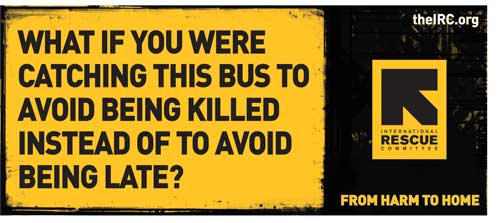

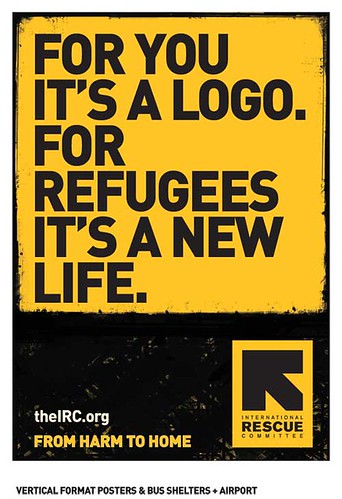
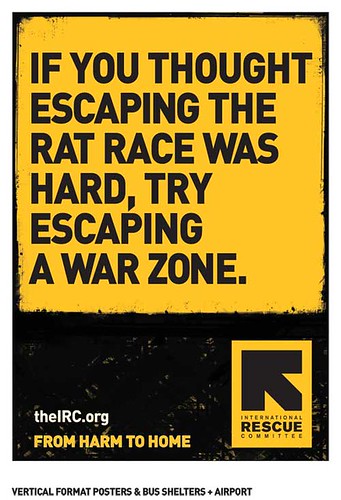

Tuesday, June 12, 2007
Leave the Ivory Tower, Now!
After 5 months of learning, talking and getting up to speed here at International Rescue Committee, I finally got myself out into the field. I visited our San Diego and Phoenix resettlement operations. This post is a sneak preview to the official version that will go up on our blog shortly - but I think for marketing purposes, it's important for me to share it here as well."Dreams and Disorientation"
When was the last time you were moved to take action?
This post isn’t intended to get you to take action, or to make a donation to the IRC. But there’s a good chance you just might because you will most certainly be moved, surprised and compelled to, at minimum, learn more about what I’m going to talk about. If I can manage to write what I have in my head you will literally be astounded.
Americans take the “American Dream” for granted. Big time.
For me, growing up in Westchester County, NY, college, a career and a family were only ever a question of time. It’s a given for many Americans that if they work hard they can live the life of their dreams. But to me, the "American Dream" isn’t really “American” – it’s more of a statement about the spirit of ALL human beings and their desire to live the life of their dreams.
I spent a few days last week with our San Diego and Phoenix resettlement offices seeing first-hand how “the dream” works for refugees. These offices are in the business of delivering the "American Dream" on a daily basis.
I bet you haven’t heard about the ’72 Burundians. I hadn’t. They are a group of refugees who fled their homeland in 1972 following a campaign of violence against them by Tutsi-led forces. What happened is sometimes referred to as the first genocide in Africa’s Great Lakes region and -- two decades before the atrocities depicted in “Hotel Rwanda” -- resulted in 200,000 deaths and triggered the flight of some 150,000 refugees to camps in Tanzania, Rwanda and Congo.
These folks have lived in refugee camps for 35 years. Two generations of people growing up in refugee camps. The government of Tanzania has made it clear that it doesn’t want them to settle permanently – but isn’t 35 years of living somewhere “permanent?”
What if you were kicked out of your house and run off to a foreign country – then after 35 years told to leave?
As for “the dream” - I have to give pause and wonder to myself how these people had any hope at all for a better life.
I met Augustine and his beautiful family (his wife and 3 young boys) as part of my tour of the Phoenix resettlement office. Resettled refugees like Augustine typically travel for up to 4 or 5 days to get from their camp to the United States. Our trip to Augustine’s house was the IRC’s “24 hour” visit – a chance for staff to check in on the family and answer any additional questions they may have.
Before my visit, I could only guess at how confused and disoriented refugees like Augustine must feel when they first arrive. But then the reality of his experience started to sink in. It was confusing and disturbing to me on so many levels:
Augustine grew up in a refugee camp and doesn’t know what an air conditioner is, or butter for that matter. He asked us what a bag of pasta was for – he held up a box of Pop Tarts and with a look of hope and confusion listened while we told him it was a breakfast food, sort of like bread with fruit inside. But Augustine now finds himself in a furnished apartment, with an opportunity for education and a job--and, of course, Pop Tarts and Cheerios. Thanks to the IRC, he's standing on the doorstep of "the dream."
In my eyes, Augustine is a hero – he is a man that I can only bow down to and honor. He has survived something that for any American is completely inconceivable. He is raising his family amid all kinds of upheaval, he speaks 5 languages and he has found a way to build a better life for them. I’m in awe.
Later that evening, I decided to go along with IRC staff to the airport to pick up another set of incoming Burundians who had been traveling for 5 days. At 11:16, a group of African men wearing standard issue gray shirts, blue pants and basic sneakers came walking down towards us, their eyes bleary, holding on to their IOM issued bags with their papers – their permission slips to "the dream."
As we stood around baggage claim, communicating in smiles and gestures, we soon learned that 3 of their 5 bags had been “lost” by the airlines. Americans get upset when they lose a bag with their pool toys and bathing suits. These folks lost bags with everything they own in them. The airline representative made us fill out forms and told us to call in 24 to 48 hours. Welcome to America!
Imagine if you packed your house to move cross-country, and the moving truck got into a wreck that destroyed everything inside.
I can imagine it – and it’s just horrible. But the newly arrived refugees just smiled. One of them picked up a copy of USA Today (he speaks no English at all) and found the weather map. He was looking intently at it and I leaned over to see if I could help him make sense of things. He pointed to Arizona and smiled. I pointed out New York and made an airplane motion with my hands - I think he understood me perfectly well.
Wednesday, April 25, 2007
Idol Gives Back
Ellen's suggestion a few minutes ago that kids donate a dollar and ask their parents to match with $9 more was a terrific moment.Both my kids silently watched as Simon and Ryan talked about a woman with 14 kids, many of them with AIDS living in a room the size of a tent.
My older girl asked me what HIV was.
There are 2 ways to look at this the CMO of a major NGO Aid agency who is not directly benefiting from Idol Gives Back.
The first way isn't worth spending much time on and was totally out of our control. I've gotten at least 10 emails from board members, colleagues and others lamenting that Save the Children is one of the beneficiaries, but we're not. What can I say, they didn't pick us - there are probably a dozen reasons - we simply didn't make the cut.
The second way is my way. My way celebrates abundance and places a bet that this could be a tide that raises all boats. I don't have the stats at my fingertips, but I am sure I read recently that international aid giving is very low in comparison to other types of charities. I also know from my research that developing new donors to support international issues is an extremely difficult task.
Relatively speaking, getting someone to donate to a cancer charity when their dad got diagnosed is a walk in the park vs. trying to help someone understand the issues in Darfur, let alone getting them to open their wallets.
So here's to Save the Children, Boys and Girls Clubs and America's Second Harvest (and the rest of the bunch)!
P.S. Ryan just announced that they've raised more than $30 million.
Tuesday, March 20, 2007
Graphic Designer Position
Are you a graphic designer? Do you know one? If so, this post is for you!I'm excited to post that I'm hiring a full-time senior level graphic designer here at International Rescue Committee. Before you get too excited, see my non-HR approved job info below.
Please consider contacting me immediately if...
- You have lots of experience (noobs need not apply for this gig) because...
- You like working on a huge variety of things from print brochures and marketing materials to web sites, microsites, flash pieces and a plethora of other web goodness which means...
- You are very flexible, and not just with Down Dog. If you don't know the difference between GIF and JPEG and have no web experience you should not apply.
- However... please do apply if you've been trained in print production but have been working on the web for the past few years.
- You are in NYC (we're across the street from Grand Central for an easy commute)
- You are interested in saving the world in your own little way.
Monday, March 19, 2007
Yes - It's Not Working!
I've recently started to believe the hype around mobile marketing and wanted to try something/anything to see how it all works. I jumped in with two feet and quickly learned that the mobile marketing landscape is pretty much a mess. I read a lot and talked to a few vendors and learned all about the different carriers, the high cost of transactions and different technologies (MMS, SMS, WAP, etc). Because of my relatively small brain, I got quickly confused, just before depression set in. I plunged forward anyway.We struggled to find the right marketing approach and eventually settled on using a mobile messaging strategy to support an online petition to stop violence against women. The thought was: once users sign the petition they can give us their mobile number (U.S. carriers only please!) and we'd send them periodic updates on how the petition was going.
Before settling on this "information strategy" we considered a donations campaign and even thought through creating an IRC "mobile club" that would give subscribers access to special content (wallpapers, icons and ringtones). We nixed that idea though because of the cost structure (a huge % of each payment would go to the carriers) that it was premature and inappropriate at this time. We also had the thought that maybe we should try walking before running.
In any case, there was good news and bad news. The best news comes directly from this attempt failing pretty badly. With more than 5,800 signatures and 7 registered mobile subscribers we learned that no one is taking us up on our offer. We'll need to really figure out if we've got an audience problem or a value proposition problem (my guess is we have a little of both). I'd much rather have an early setback with nothing at stake in ventures like this.
More good news includes the vendor we're working with. The msgme interface is amazingly clean and simple - and provided me with the ability to quickly test and set up my campaign.
The bad news is that mobile marketing (like anything) isn't as simple as we were hoping. Hope not being a strategy, this shouldn't have been surprising. We'll continue to try to find new ways to build relationships with our constituents and I'll keep letting you know what works and what doesn't.
In the meantime - please sign our petition to stop violence against women!
Sunday, February 11, 2007
The IRC in Second Life
Yes, I'm a bit schizo regarding Second Life - but there is no doubting that there is something interesting going on which needs to be explored...And so with huge thanks to the folks at Better World Island and Riversong Garden, the IRC has it's first ever presence in Second Life as part of the NMConnect Media Arts Symposium. At the last possible minute, space was made available to us and Riversong was able to get an installation up and running. The artwork is actually from a trade show display being shown this week in Las Vegas at the Project show.
If you are a Second Life user, you can visit the installation (this is a SLURL link that will launch Second Life directly.
I made a very short video (pass it around after making some comments please):
You can also check out pics on Flickr.
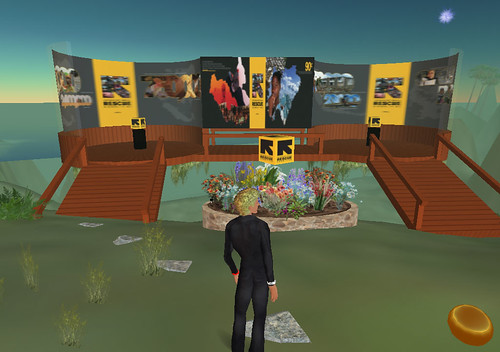
Tags: secondlife, theirc
Friday, January 05, 2007
Your new job is calling...
Ever wanted to be the CTO for an international organization? Now is your chance... The International Rescue Committee is hiring a CTO. For details, email me and we'll chat.Responsibilities will include setting network strategy (and implementation), developing application and data integration strategies up and everything else that a CTO would do.
Please let me know if you are interested or simply pass along my contact info to anyone you know who might be interested.
The job is in NYC - half a block from Grand Central.

